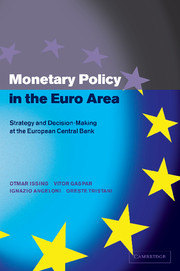Book contents
- Frontmatter
- Contents
- List of figures
- List of tables
- Acknowledgements
- Introduction
- 1 Money, output and prices: the scope of monetary policy
- 2 Monetary policy making: strategies and rules
- 3 The euro area: an overview
- 4 The ECB strategy: defining price stability
- 5 The role of money
- 6 A broadly based assessment
- 7 The ECB strategy: an overall view
- 8 The operational framework
- 9 Accountability and transparency
- 10 The single monetary policy in 1999
- Appendix Excerpts from ECB external communications to the press
- References
- Index
4 - The ECB strategy: defining price stability
Published online by Cambridge University Press: 22 September 2009
- Frontmatter
- Contents
- List of figures
- List of tables
- Acknowledgements
- Introduction
- 1 Money, output and prices: the scope of monetary policy
- 2 Monetary policy making: strategies and rules
- 3 The euro area: an overview
- 4 The ECB strategy: defining price stability
- 5 The role of money
- 6 A broadly based assessment
- 7 The ECB strategy: an overall view
- 8 The operational framework
- 9 Accountability and transparency
- 10 The single monetary policy in 1999
- Appendix Excerpts from ECB external communications to the press
- References
- Index
Summary
With this chapter, we begin describing the actual monetary policy strategy adopted by the ECB. Our starting point is the definition of its primary objective, namely price stability.
At first sight, it may be surprising to find a discussion of price stability within the ECB strategy. Both the objective of price stability and its overriding nature are part of the mandate of the ECB, as defined in the Treaty. As such, price stability is logically distinct from the monetary policy strategy, i.e. the way in which the ECB plans to achieve its mandatory goal. Moreover, the commitment to price stability cannot be subject to revisions at the initiative of the Governing Council. While the latter is in principle free to modify the strategy, the commitment to price stability is ‘written in stone’. It has the democratic legitimacy of an international treaty, signed by the governments of the fifteen Member States and ultimately sanctioned either by Parliament approval or by referendum. The role of price stability as an overriding goal of monetary policy, therefore, is taken as given by the ECB (see also Issing, 2000a).
Nevertheless, when devising its monetary policy strategy, the ECB faced the key decision of whether to announce a precise, numerical definition of price stability. As we argue in this chapter, the announcement of a quantitative definition for the price stability objective represents an important form of commitment. In this respect, the announcement can be seen as an integral part of the strategy.
- Type
- Chapter
- Information
- Monetary Policy in the Euro AreaStrategy and Decision-Making at the European Central Bank, pp. 65 - 75Publisher: Cambridge University PressPrint publication year: 2001
- 3
- Cited by

